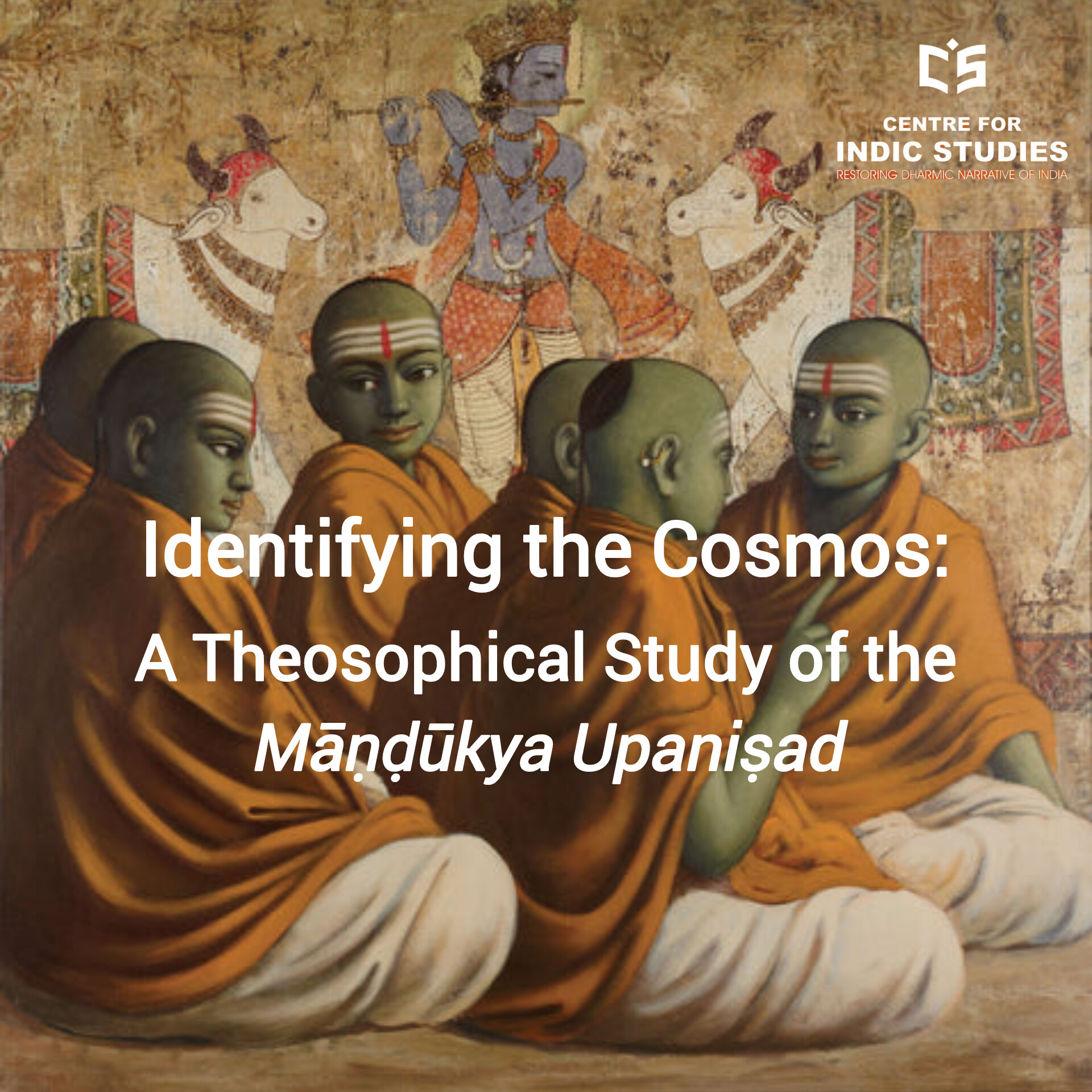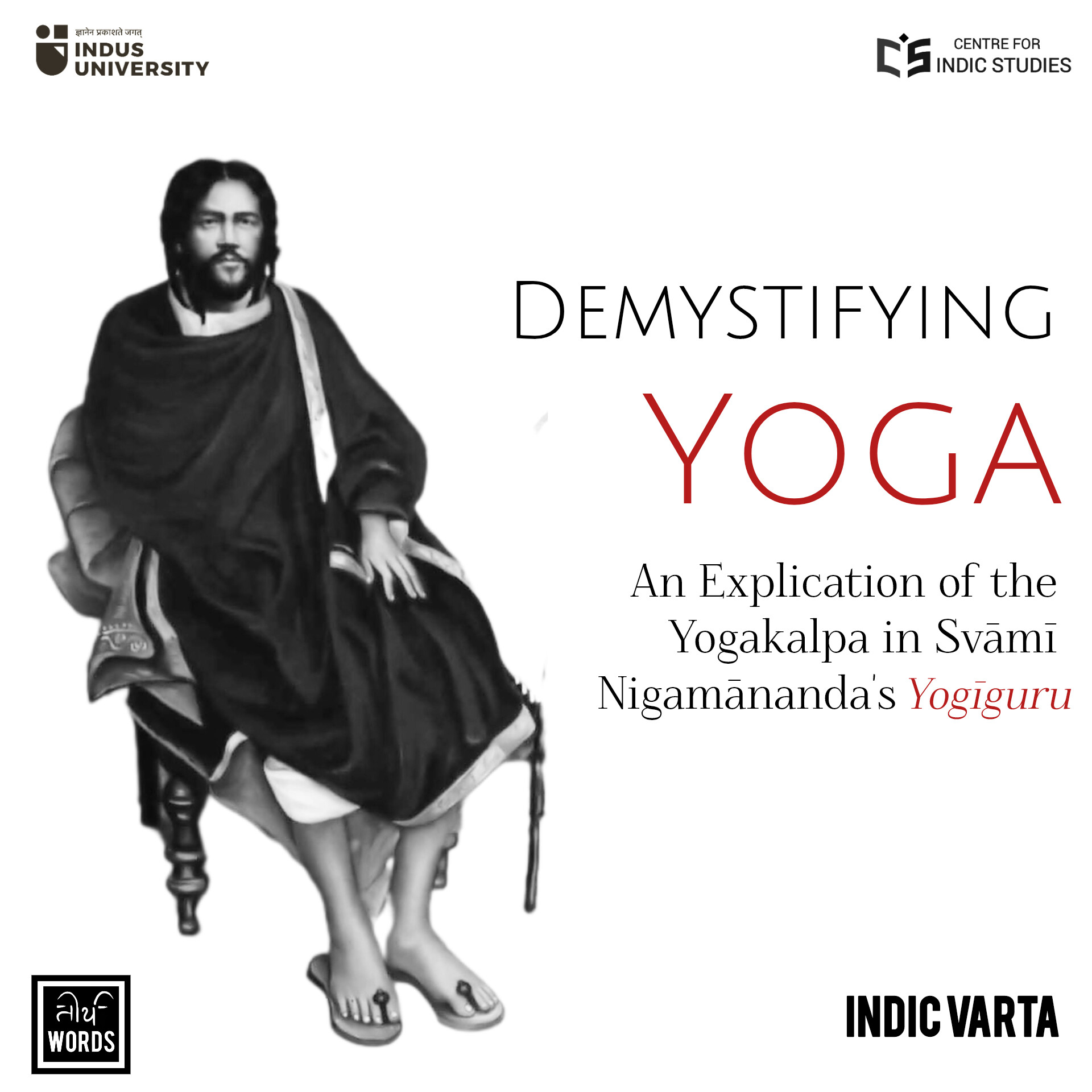- Visitor:79
- Published on: 2024-09-18 01:06 pm
Identifying the Cosmos: A Theosophical Study of the Māṇḍūkya Upaniṣad
Whereas all the Upaniṣads aim at the anagnorisis of the scientific wisdom (from the atomic and subatomic particles to the extraterrestrial phenomena), the Māṇḍūkya Upaniṣad succinctly lays bare the theosophical contemplation of the cosmological identity.

Introduction
Whereas all major theosophical literatures of the Abrahamic religions have pondered over the act of creation and the cataclysm of the cosmos, none did ever venture to scientifically elucidate its identity. Let alone be Abrahamic faiths, tracing the identity of the cosmos has also lurked in obscurity even in the pagan and heathen cultures that flourished in ancient Europe which were much more scientific than the formerly mentioned religions. However, the Sanātana Dharma which anchors in the Vedas is conspicuously unique in this prospect. Time and again, it has succinctly demystified, inter alia, the orchestration and the identity of the cosmos. The Māṇḍūkya Upaniṣad is one of such seminal texts of the Sanātana library which can be taken into account in this regard. Although it is the puniest of all its denominations, it possesses a stark contrast when it comes to significance and merit. In this paper, I shall endeavour to analyze how this classical text has linked the bridge between theosophy and modern physics in tracing the identity of the cosmos. This paper exemplifies qualitative research and the library method has been applied to substantiate the claims that it makes. As the original text is in Saṃskṛta (Sanskrit), citations will either be transliterated by using the International Method of Sanskrit Transliteration (IAST), or they will be pasted in toto as they are for the sake of the scholarly purpose. The paper lucubrates on the identity of the cosmos in the aura of the Sanātana theosophy.
In the Sanātana Dharma, there has been a prevalence of the analogy that whereas the Vedas are like a cow, the Upaniṣads are like the milk she produces. The profundity of the Vedas can be magnanimous for the multifarious acts of life, but the laconic compendia of the esoteric theosophy and cognitive formulae that are found in the Upaniṣads, the conclusive parts of the Vedas, are the essence of the scientific discourse. Whereas all the Upaniṣads aim at the anagnorisis of the scientific wisdom (from the atomic and subatomic particles to the extraterrestrial phenomena), the Māṇḍūkya Upaniṣad succinctly lays bare the theosophical contemplation of the cosmological identity.
The very inception of the Māṇḍūkya Upaniṣad is trailblazing as the first śloka unequivocally heralds that the entire cosmos is filled by the supreme akṣara known as the ‘ॐ’ and the cognizance of this fact has been celebrated as the purpose of the following ones. The past, the present, and the future of the cosmos are linked to this identity. The cosmos has its origin, function, and dissolution in the supreme being called the Brahma and its denominative form is the ‘ॐ’ itself:
ॐ इत्येतदक्षरमिद̐˴ सर्वंतस्योपव्याख्यानं
भूतंभवद्भविष्यदिति सर्वमोङ्कार एव
यच्चान्यत्त्रिकालातीतं तदप्योङ्कार एव ॥
(Māṇḍūkya Upaniṣad 1)
[The entire cosmos is the explicative form of the supreme akṣara called ‘ॐ’ and although it is beyond the cycle of time, it regulates the past, present, and future.]
Despite the fact that this supreme being regulates the cycle of time, it is aloof of the time’s clutch. All the dimensions (including time) have sprung from this ‘ॐ’ and will dissolve into it. Although it is compact, absolute, and infinite by itself, its virtues will remain unhindered even when they are withdrawn from it. Paradoxical and self-contradictory it may sound, but it has been reiterated in the Bṛhadāraṇyaka Upaniṣad (5.1.1):
ॐ पूर्णमदः पूर्णमिदं पूर्णात् पूर्णमुदच्यते ।
पूर्णस्य पूर्णमादाय पूर्णमेवावशिष्यते ॥
ॐ शान्तिः शान्तिः शान्तिः ॥
[The eternally blissful and the self-fulfilled Brahma is infinite and this cosmos is also filled by its infiniteness as it has originated from that self. Even if the infiniteness from the infiniteness is taken away, infiniteness shall remain.]
The reason which lies behind this epigrammatic statement is that infinity and absoluteness cannot be measured and nothing can exist beyond them. Therefore, withdrawing something from the infinite is actually supplying the infinity at the same time. As Mahānāmbrata Brahmacārī rightly illustrates:
The ॐ has no end, nor any beginning. It is the Brahma. It is the sound and the silence both…It is the first and the last śabda (word), the first and the last pratīka (symbol), and the first and the last of the sattvā (essence). It is the be-all and the end-all of the cosmos. It does not have any meaning of its own as it is the source of all meanings.
(Veda Vicintan, p. 293)
The entire cosmos is, de facto, nothing but the incarnation of the Brahma. It is the Brahma that comprises the mass and the spirit en tout as validated by Bṛhadāraṇyaka Upaniṣad (3.7.23):
योरेतसि तिष्ठन्रेतसोऽन्तरोय ̐˴रेतोनवेदयस्य रेतः
शरीरं योरेतोऽन्तरोयमयत्येष त आत्माऽन्तर्याम्यमृतोऽदृष्टो
द्रष्टाऽश्रुतः श्रोताऽमतोमन्ताऽविज्ञतोविज्ञाता।
नान्योऽतोऽस्ति द्रष्टा नान्योऽतोऽस्ति श्रोता
नान्योऽतोऽस्तिमन्ता नान्योऽतोऽस्ति विज्ञातैष
त आत्माऽन्तर्याम्यमृतोऽतोऽन्यदार्तं
ततोहोद्दालक आरुणिरुपरराम ॥
[The Brahma sees everything, but it cannot be seen; it hears everything, but it cannot be heard; it thinks everything, but it cannot be thought of; it knows everything, but it cannot be known. Except it, none actually sees, hears, thinks, and knows anything. It resides in us as the ātmā which is immortal.]
The abovementioned śloka implies that the Brahma is the body and the spirit of the cosmos. It is omnipresent, omnipotent, and omniscient. It is one and absolute. However, the second śloka of the Māṇḍūkya Upaniṣad infers four salient features of the supreme spirit. Although the Brahma is undividable, these features meticulously help us to conceive an idea of the one who is beyond all conception, only for the sake of mundanely scientific understanding. These features can together be framed as a notion of the identity of the cosmos. They are expounded below.
वैश्वानरः -- the Cosmic Mass
The Law of Conservation of Mass discovered by Antonio Lavoisier in 1789 asserts that the “mass is neither created nor destroyed in chemical reactions. In other words, the mass of any one element at the beginning of a reaction will equal the mass of that element at the end of the reaction” (Sterner et al., 2011). It would not be a hypothetical exaggeration to state that the theory behind the concept of the ‘वैश्वानरः’ (Vaiśvanaraḥ) proposed by the third mantra of the Māṇḍūkya Upaniṣad also indicates the same notion:
जागरितस्थानो बहिष्प्रज्ञः सप्ताङ्ग एकोनविंशतिमुखः
स्थूलभुग्वैश्वानरः प्रथमः पादः ॥
[Life, mind, senses, sound, air, fire, water, and earth have originated from the Brahma. This is the physical manifestation of the Brahma and the first of its features. As it is a part of Brahma, it is absolute.]
The abovementioned mantra enunciates that the sthula (materialist) aspect of the cosmos is the first pāda of the Brahma. The seven lokas (viz. the bhūḥ or the earth; the bhuvaḥ or the region between the earth and the sun; the svaḥ or the heavenly constellation between the seven stars and the sun; the mahaḥ or the region preceding the seven stars; the jana or the region of the seven stars; the tapaḥ or the ethereal sphere of the cosmos; and the satya or the region of the creation of the universe) are the materialist aspects of the Brahma. However, the reader must be cautioned that the Brahma is beyond the limitations of these aspects as it is the abode of these celestial elements. Apart from them, in our mundane lives, the five jñāna indriyas (the five sensory organs), the five karma indriyas (the five acting organs), the five prāṇas (the five elementary airs), and the four karaṇas (the four dimensions of the self) are also considered as the nineteen faces of the Vaiśvanaraḥ who relishes and feels every physical aspect. This is why, the sthula aspect of the Brahma is called ‘वैश्वानरः’ (the cosmic mass). It can be referred to Śrī Kṛṣṇa’s explication of this notion in the Bhagavad Gītā (5.29 and 9.24) where he perspicuously asserts that everything of the cosmos that are found as physical entities actually resides in the body of the Brahma:
भोक्तारं यज्ञतपसां सर्वलोकमहेश्वरम्।
सुहृदं सर्वभूतानां ज्ञात्वा मां शान्तिमृच्छति।।
…………......................................................
अहं हि सर्वयज्ञानां भोक्ता च प्रभुरेव च।
न तु मामभिजानन्ति तत्त्वेनातश्च्यवन्ति ते।।
[My devotee knows me as the cosmic consumer of all the aspects of the universe as I am the constitution of the cosmos. Knowing this, my devotee remains good-hearted, unselfish, kind, and amicable to all. He, who does not know that I am the constitution and the lord of the cosmos, is doomed into the darkness of ignorance which results in the recycle of life.]
As the mass of the cosmos is actually the physical manifestation of the Brahma, it is inevitably absolute and can neither be created, nor be destroyed – just like Antonio Lavoisier stated in his theory that is mentioned ab initio of this segment. However, it is worth mentioning that the greatest theologian and philosopher of the 8th century CE and the preacher of the Advaita Vedānta, Ādi Śankāracārya, had already enucleated this in his bhāṣya (commentries) on the Brahmasūtra. In his commentaries (1.2.24), he writes on the mantra:
ॐ वैश्वानरः साधारणशब्दविशेषात् ॐ ॥
[The Vaiśvanaraḥ is the general word for (one of the) aspects of the cosmic person or the supreme lord.]
The conversation between Aśvapati Kaikeya and the five metaphysical theologians mentioned in the Chāndoyga Upaniṣad (5.11-18) reiterates the term ‘वैश्वानरः’ multiple times and exuberantly illustrates the various domains of the notion. The five theologians are Oupamanyava, Pouluṣi, Bhāllaveya, Jana, and Buḍila respectively. They all were looking for the answer to the grand question: ‘What is our self and what is Brahma?’ So, these five theologians united and approached sage Uddālaka Āruṇi who directed them to the king called Aśvapati Kaikeya who satisfied their quest for the sacred wisdom by elaborating the notion of the ‘वैश्वानरः’ in a question-answer segment.
Aśvapati first enquired Oupamanyava whom he worshipped as the Ātmā Vaiśvanaraḥ (the cosmic mass), to which he replied that he hails dou (the soil) as such. King Aśvapati corrected him saying that the dou whom he worshipped is actually only the mūrdhā (head) of the Ātmā Vaiśvanaraḥ, not the entire self. He then asked Pouluṣi the same question and his answer was āditya (sunbeam or fire). Aśvapati corrected him saying that it is only the cakṣu (eyes) of the Ātmā Vaiśvanaraḥ, not the entire self as well. The king then reiterated the question to the third of the theologians, Bhāllaveya, and he answered that he considered vāyu (air) as the Ātmā Vaiśvanaraḥ. But the king rectified him, explaining that it is only the prāṇa (heart), not the whole self. Then the fourth theologian, Jana, was also asked the same question and his answer was ākāśa (firmament). Aagin, the king explained that it is only the upper torso of the Ātmā Vaiśvanaraḥ, not the entire self. The fifth theologian, Buḍila, was asked the same question and his answer came as jala (water). The king corrected him too, saying that it is only the lower torso of the Ātmā Vaiśvanaraḥ, not the whole self. Much like the famous parable of the Blind Men and the Elephant which was first depicted in the Ṛgveda (Giffiths, pp. 46-47) and later became the source of John Godfrey’s poem with the same title as the parable, king Aśvapati eventually enlightens them by clarifying the misunderstanding of their specific approaches and proposed a holistic view.
He clarified that all the brāhmaṇas were contemplating on the partial apparatus of the Brahma. He then inculcated them with the true nature of the omnipresent Brahma and this sacred wisdom has been hailed as the Vaiśvanaraḥ Vidyā:
तान्होवाचैतेवैखलु यूयं पृथगिवेममात्मानं
वैश्वानरं विद्वाꣳसोऽन्नमत्थ यस्त्वेतमेवं
प्रादेशमात्रमभिविमानमात्मानं वैश्वानरमुपास्तेस सर्वेषु
लोकेषुसर्वेषुभूतेषुसर्वेष्वात्मस्वन्नमत्ति ॥
तस्य ह वा एतस्यात्मनोवैश्वानरस्य मूर्धैव
सुतेजाश्चक्षुर्विश्वरूपः प्राणः पृथग्वर्त्मात्मा संदेहो
बहुलोबस्तिरेव रयिः पृथिव्येव पादावुर एव वेदिर्लोमानि
बर्हिर्हृदयं गार्हपत्योमनोऽन्वाहार्यपचन आस्यमाहवनीयः॥
[All of you have been contemplating upon the different limbs of the Vaiśvanaraḥ rather than its entire form. Until and unless one realizes that it is the Vaiśvanaraḥ which constitutes everything and that everyone resides in it, the person’s intellect remains confined to a narrow dogma. The sun is the head of the Vaiśvanaraḥ, the world is its eyes, and the umpteenth numbers of the spirits or the cosmic elements constitute its torso. The force is its abdomen, the soil is its feet, wisdom is its chest, the mountains are its hair, the fire of the household is its heart, the fire of the pyre is its mind, and the fire of the earth is its mouth.]
तैजस: -- The Cosmic Energy
The law of conservation of energy, which is regarded as an integral part of theoretical physics and quantum thermodynamics, was first discovered and tested by the Newtonian scientist, Émilie du Châtelet. It states that “energy can neither be created, nor destroyed – only converted from one form of energy to another. This means that a system always has the same amount of energy” (Campbell et al., 2020). Quite similar a theorem is also stated in the fourth mantra of the Māṇḍūkya Upaniṣad where the cosmic energy has been considered as absolute and infinite:
स्वप्नस्थानोऽन्तःप्रज्ञः सप्ताङ्ग एकोनविंशतिमुखः
प्रविविक्तभुक्तैजसो द्वितीयः पादः॥
[Intangible and abstract is the state of the energy. Its wisdom has filled the cosmos. With its seven limbs and nineteen mouths, it consumes everything. This energy belongs to the hiraṇyagarva and it is the second feature of the Brahma.]
The Sanskrit term ‘तैजस:’ refers to the cosmic energy and it has been considered as the second pāda of the Brahma. The cosmic energy or the nimbus is the reason behind the prakāśa (function) of all the objects. In different texts of the Sanātana Dharma, it has been ascribed with different nomenclatures such as the ‘jyoti’ (luminosity) and ‘hiraṇyagarva’ (the auriferous light). For instance, the Taittrīya Brāhmaṇa (3.12.9.7) terms it ‘येनसूर्यस्तपतितेजसेद्धः’ (the burning fire of the sun) and Chāndoyga Upaniṣad (3.13.7) delineates it as the ‘पुरुषेज्योतिः’ (the aura of god):
अथ यदतः परोदिवोज्योतिर्दीप्यतेविश्वतः पृष्ठेषु
सर्वतः पृष्ठेष्वनुत्तमेषूत्तमेषुलोकेष्विदं वाव
तद्यदिदमस्मिन्नन्तः पुरुषेज्योतिः॥
[The luminous aura that is found in every sublime sphere of the cosmos has originated from the aura of the Brahma. It is the same energy that also resides as the spirit in the body.]
This cosmic energy is sūkṣma (exquisitely subtle) and it cannot be measured or comprehended by the mundane beings. It is as mystical and cunning as a dream. It is the source of the spur for all the actions that take place in the cosmos. In other words, it is this śakti that runs the cosmic functions. That is why, Ādi Śankāracārya in his commentaries on the Brahmasūtra (1.1.24) has held it with great reverence:
ॐ ज्योतिश्चरणाभिधानात् ॐ ॥
[The jyoti or the light is the Brahma and it is the energy of the cosmos.]
This ‘तैजस:’ is inexorable and unfathomable as it is the second aspect of the Brahma. Therefore, the parallel drawn between this theosophical notion and the empirical scientific law of the conservation of energy is justified and validated.
Continue reading the second part (click here)
- 39 min read
- 3
- 0










